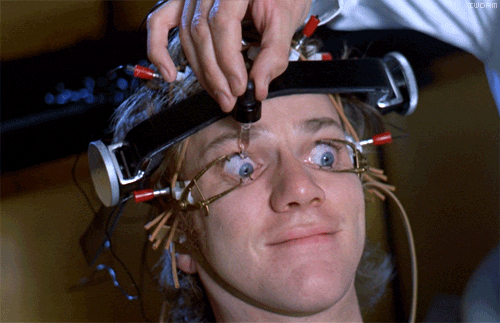Stanley Kubrick
From the opening shot of Stanley Kubrick’s A Clockwork Orange, evil stares back at the audience in the form of a teenager named Alex DeLarge. The camera pulls back and we are progressively shown the rest of the room including Alex’s delinquent friends and the bizarre white statues of women in sexual poses. Alex is carefully positioned in the center of the frame not just because he is the subject of this film but also because, as we will see later, his extreme narcissism leads him to believe the world revolves around him. From its angular perspective, the room is set up like a symbolic food chain of teenage boys and Alex and his close friends are at the top. The white nude statues in submissive poses are a clear representative of how these boys view women throughout the rest of the film: as mere sexual objects. A Clockwork Orange is a movie set in the future but young men like Alex and his friends have always existed throughout every civilization.
Based on the novel by Anthony Burgess, Stanley Kubrick envisions a dystopian near-future Britain where youth violence has become an epidemic. The film follows the disturbing crime sprees of Alex and his gang that include attacking innocent people and raping women. Alex is eventually captured by the police and is placed in a rehabilitation experiment using a psychological conditioning technique.
Same with The Shining, 2001: A Space Odyssey, and the rest of his outstanding work, Stanley Kubrick creates unforgettable images and sequences in A Clockwork Orange that have become ingrained into cinematic history. A Clockwork Orange might be the most thematically challenging film Kubrick made as its lead protagonist is one of cinema’s most unforgettable villains. Where many mainstream movies spoon-feed their message to the audience and give us cookie-cutter characters, Kubrick gave us a character who is as entertaining as he is despicable. Like a meticulous surgeon, Kubrick presents us with carefully-composed images but he doesn’t assert his opinion of the characters, he just allows them to be. This is why many audiences accused Kubrick of glorifying violence and misogyny because the film doesn’t overtly say where it stands on Alex’s behavior.
Like the novel, the movie is a warning about the two potential extremes society can fall into. One side is the dangers of not having enough order and structure in society. When families are broken and governments are corrupt, violence always springs up. Young boys are drawn to delinquency and women become easy targets of testosterone-driven brutes. In the film you see the disconnect between Alex and his parents and the surprising sexual assault from the school principal who shows up in his bedroom. You also see some of the villainous characters easily obtain jobs as government employees without any repercussions for their terrible acts. Alex is truly evil but almost all the adults around him are corrupt too. His society has helped nurture his behavior, like the glass of milk he drinks in the opening shots of the film.
The other danger is having a government that has too much control of its citizens. Almost all fascist leaders have an obsession with extreme cleanliness and this obsession moves on to legislation. These fascist governments can easily label a certain group as “dangerous” and they will either exterminate or attempt to “purify” those who don’t line up with their ideas. The conditioning experiment Alex is put through is a power that can become a dangerous weapon if it were to fall into the hands of an evil leader or malicious government. The results of the experiment show us how Alex is not truly rehabilitated but only externally does he becomes a powerless creature and a target for those who want to trample him.
Could Alex ever change and become a better person? Anthony Burgess’s novel has a much more optimistic ending. Kubrick chose to go in another direction and this conclusion proved to be more powerful than the novel’s ending. How Kubrick chose to close the story is one of the many reasons why A Clockwork Orange will continue to be an important work of art for generations to come.
director STANLEY KUBRICK
year 1971
director of photography JOHN ALCOTT
cast MALCOLM MCDOWELL, PATRICK MAGEE and ADRIENNE CORRI
words HECTOR ORTIZ
What to read next







